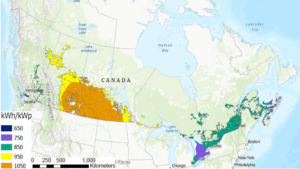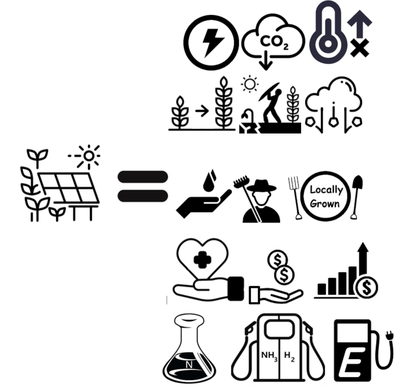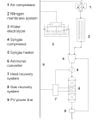
Canada has committed to reducing greenhouse gas (GHG) emissions by increasing the non-emitting share of electricity generation to 90% by 2030. As solar energy costs have plummeted, agrivoltaics (the co-development of solar photovoltaic (PV) systems and agriculture) provide an economic path to these goals. This study quantifies agrivoltaic potential in Canada by province using geographical information system analysis of agricultural areas and numerical simulations. The systems modeled would enable the conventional farming of field crops to continue (and potentially increase yield) by using bifacial PV for single-axis tracking and vertical system configurations. Between a quarter (vertical) and more than one third (single-axis tracking) of Canada’s electrical energy needs can be provided solely by agrivoltaics using only 1% of current agricultural lands. These results show that agrivoltaics could be a major contributor to sustainable electricity generation and provide Canada with the ability to render the power generation sector net zero/GHG emission free. It is clear that the potential of agrivoltaic-based solar energy production in Canada far outstrips current electric demand and can, thus, be used to electrify and decarbonize transportation and heating, expand economic opportunities by powering the burgeoning computing sector, and export green electricity to the U.S. to help eliminate their dependence on fossil fuels.
See also[edit | edit source]

- Coal with Carbon Capture and Sequestration is not as Land Use Efficient as Solar Photovoltaic Technology for Climate Neutral Electricity Production
- Dual use of land for PV farms and agriculture literature review
- sheep
- Israeli white plastic reflectors
- A Farmer's Guide to Going Solar (NREL)
- German guidelines: https://www.ise.fraunhofer.de/content/dam/ise/en/documents/publications/studies/APV-Guideline.pdf
- 2021 review
- Miskin, C.K., Li, Y., Perna, A., Ellis, R.G., Grubbs, E.K., Bermel, P. and Agrawal, R., 2019. Sustainable co-production of food and solar power to relax land-use constraints. Nature Sustainability, 2(10), pp.972-980.
- Retrofitting solar parks for agrivoltaics
- Shading PV
- Alexis' talk at American Solar Grazing Association2021
In the News[edit source]
- Agrivoltaics: solar energy + better crops Climate and Nature
- Why solar power and farmers’ fields could be the perfect combination TVO
- Solar farms and sheep show the makings of a clean energy classic duo Business Renewables
- Agrivoltaics charge up St. Albert-area farms St Albert Gazette
- Sheep, solar and crops. How some Alberta farms are creating ideal growing conditions Western Wheel
- Sheep, solar and crops. How some Alberta farms create ideal growing conditions Voxpopuli
- Protein bars from recycled plastic bottles? An indoor farm on wheels? Western prof gets innovative with green tech Toronto Star
- 加拿大环保狂人回收塑料瓶制成蛋白棒 还有可移动室内农场!? Lahoo
- Solar
- Papers
- Agrivoltaics
- Solar power
- Solar energy
- Photovoltaics
- Sustainable development
- Agriculture
- SDG02 Zero hunger
- SDG07 Affordable and clean energy
- SDG08 Decent work and economic growth
- SDG09 Industry innovation and infrastructure
- SDG12 Responsible consumption and production
- Canada
- Energy policy
- Farming
- Energy
- Land use
- FAST Completed




































